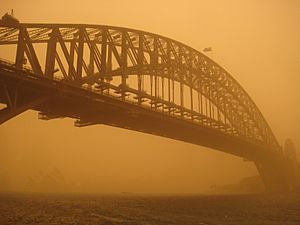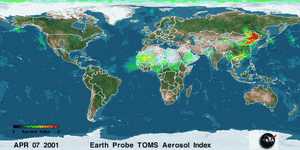Dust storm facts for kids
A dust storm, also known as a sandstorm, is a natural event where strong winds pick up loose sand and dirt from dry ground. These storms are common in very dry (arid) and partly dry (semi-arid) places around the world. Imagine a huge cloud of dust and sand moving across the land!
When strong winds blow, tiny bits of soil and sand are lifted into the air. This can make it very hard to see, like a thick fog made of dirt. Dust storms can make travel difficult and might even affect people's health. Over time, many dust storms can harm farms and turn fertile land into desert.
Places like North Africa, the Middle East, Central Asia, and China are major sources of these airborne dust clouds. Sometimes, people's farming practices in dry areas can make dust storms happen more often or become bigger.
We often call them "sandstorms" when they happen in deserts, like the Sahara, and involve a lot of larger sand particles. "Dust storm" is usually used when finer particles travel long distances, especially when they reach cities.
Contents
How Dust Storms Start
Dust storms begin when strong winds blow over very dry ground. The ground might be dry because of a long period without rain, called a drought. When the soil is dry, it becomes loose and easy for the wind to pick up.
Wind and Particle Movement
Imagine tiny sand grains on the ground. When the wind gets strong enough, these grains start to bounce and skip along the surface. This movement is called saltation. As they bounce, they hit other particles, breaking off even smaller bits of dust. These tiny dust particles are then lifted high into the air, a process called suspension.
Sometimes, as sand particles rub together while bouncing, they create a static electric charge. This charge can actually help lift even more sand into the air, making the storm bigger!
Weather Conditions That Help
Strong winds often come from two main weather events:
- Thunderstorm Outflows: When a powerful thunderstorm cools the air, this cooler air rushes outwards, creating strong gusts of wind.
- Dry Cold Fronts: A cold front moving into a dry area without bringing rain can also create strong winds. This type of storm was common during the Dust Bowl years in the United States.
The height a dust storm reaches depends on how stable the air is and how heavy the particles are. Dust can sometimes be lifted as high as 6,000 meters (about 20,000 feet) into the sky!
Human Activities and Dust Storms
Besides natural causes like drought and wind, some human activities can also make dust storms worse.
- Farming Practices: If farmers don't protect their soil, for example, by tilling it too much or not planting enough cover crops, the bare ground is easily picked up by the wind.
- Wildfires: Large wildfires can burn away plants that hold soil in place, leaving the ground exposed and vulnerable to wind erosion.
Good soil conservation methods, like planting trees or using special farming techniques, can help prevent wind from carrying away valuable soil.
Physical and Environmental Impact

Dust storms can move huge amounts of sand and dust. The front edge of a large dust storm can look like a towering wall of thick dust, sometimes as high as 1.6 kilometers (about 1 mile)!
Where Dust Storms Travel
The Sahara Desert in Africa is a major source of dust storms. Dust from the Sahara often travels across the Mediterranean Sea. It can even reach as far north as central Europe and Great Britain. Local names for these storms include "simoom" or "haboob" in places like Sudan.
Over the past 50 years, Saharan dust storms have become much more frequent. This has led to the loss of valuable topsoil in countries like Niger and Chad. For example, in Mauritania, there were only about two dust storms a year in the early 1960s. Since 2007, there have been around 80 a year. This increase in dust can even affect global weather patterns, like slightly reducing hurricane activity in the Atlantic Ocean.

Health Concerns from Dust
Breathing in dust from these storms can cause health problems.
- Breathing Issues: The tiny dust particles can irritate your lungs and make it harder to breathe, especially for people with conditions like asthma.
- Eye Irritation: Dust can get into your eyes, causing them to feel dry and scratchy. If not cleaned properly, severe cases can lead to serious eye damage.
- Long-Term Effects: Breathing in a lot of dust over a long time can lead to serious lung conditions. It's important to protect your respiratory system during a dust storm.
Dust storms can also carry tiny bacteria and fungus spores. These can mix with air pollution in cities, potentially affecting air quality.
Economic Impact
Dust storms have both negative and positive effects on economies and the environment.
- Harm to Agriculture: They can strip away valuable topsoil from farms, especially the light, nutrient-rich parts. This makes the land less fertile and reduces how much food can be grown. The strong winds and flying particles can also damage young plants.
- Transportation Problems: With very low visibility, it becomes dangerous for cars, trucks, and airplanes to travel. This can cause delays and economic losses.
However, dust can also be helpful:
- Nutrients for Rainforests: Dust from the Sahara Desert carries important minerals that act like fertilizer for the rainforests in Central and South America.
- Ocean Health: Some parts of the ocean lack iron, which is vital for tiny ocean plants. Dust storms can deliver this iron, helping ocean life thrive.
- Fertile Soils: In places like northern China and the central U.S., ancient dust storms created very fertile soils called loess. These soils are excellent for farming, but if disturbed, they can also become sources for new dust storms.
Dust Storms on Mars
Did you know that dust storms don't just happen on Earth? They also occur on our neighboring planet, Mars!
Martian dust storms can be much larger than those on Earth. They sometimes grow so big that they cover the entire planet! While the winds can reach speeds of about 60 miles per hour (27 meters per second), they don't feel as strong as Earth's hurricane-force winds. This is because Mars has a much thinner atmosphere, only about 1% as dense as Earth's.
These storms form when sunlight warms the Martian atmosphere. This warming causes the air to move, lifting dust from the planet's surface. Dust storms are more likely to happen when there are big temperature differences, especially near the Martian equator during its summer.
See also
 In Spanish: Tormenta de polvo para niños
In Spanish: Tormenta de polvo para niños
- Coccidioidomycosis
- Dry line
- Dust storm warning
- Haboob
- Iberulite
- List of dust storms
- Mineral dust
- Saharan Air Layer
- Shamal (wind)
- Sirocco




